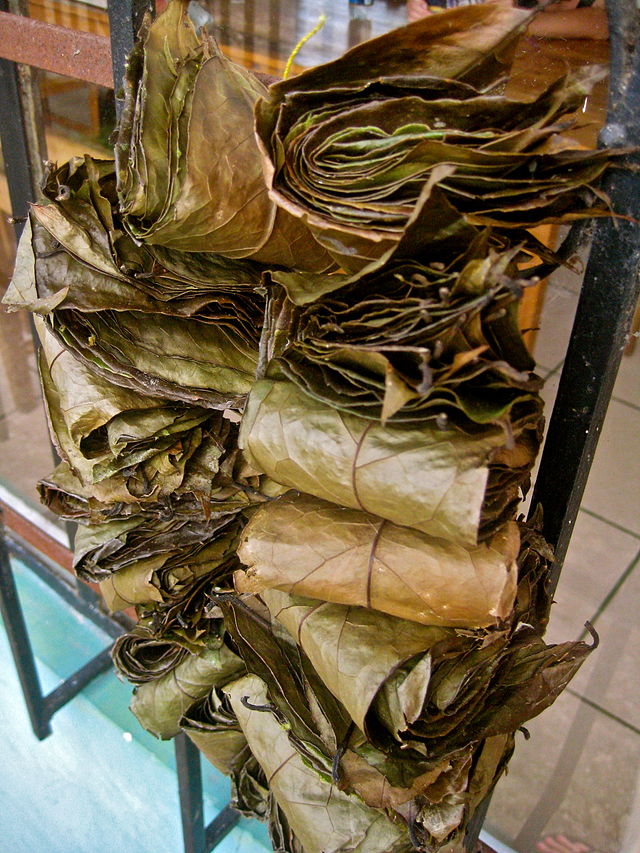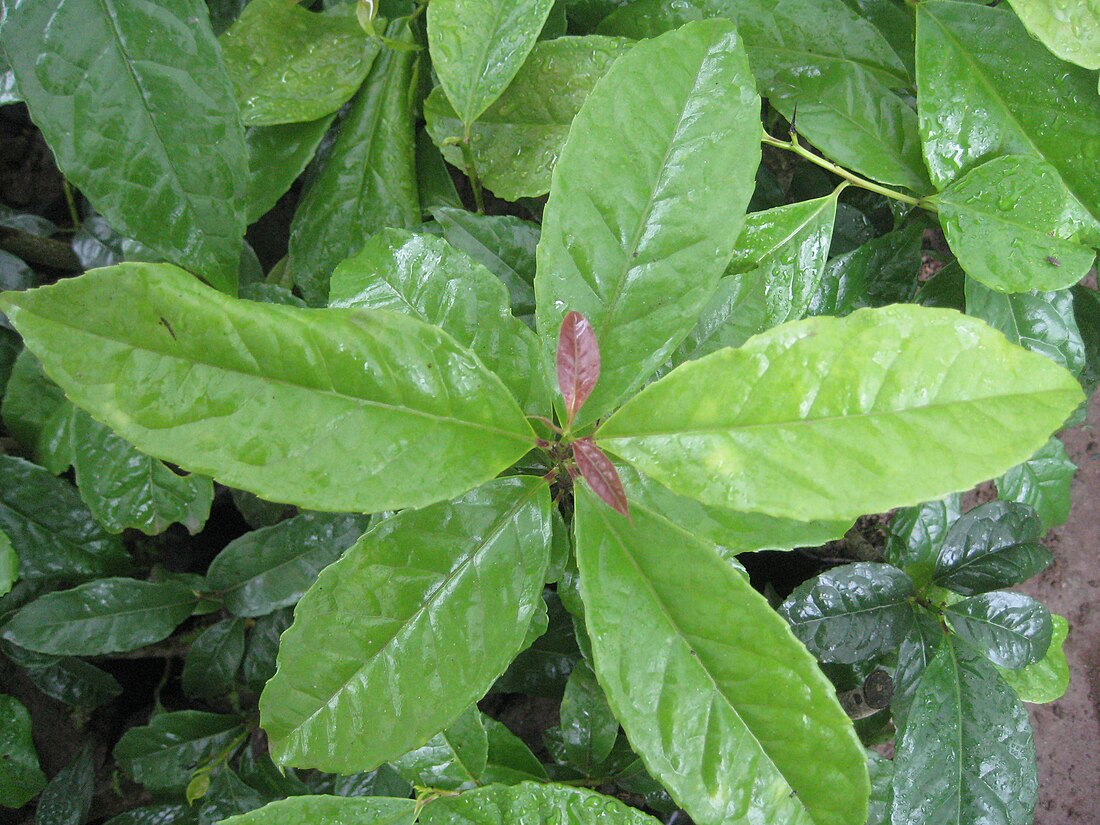Top Qs
Timeline
Chat
Perspective
Ilex guayusa
Species of holly From Wikipedia, the free encyclopedia
Remove ads
Ilex guayusa (/ˈaɪlɛks ˈɡwaɪjuːsə/ or /ˈaɪlɛks ˈwaɪjuːsə/) is a species of tree in the holly family, Aquifoliaceae.[2][3] It is native to the Amazon Rainforest. One of four known caffeinated holly trees, the leaves of the guayusa tree are harvested fresh and brewed like a tea for their stimulative effects.[4] It is known simply as guayusa in western languages like Spanish, as waisa in Kichwa and as wayus or wais in Shuar.[5][6]
Remove ads
Description
Ilex guayusa is an evergreen dioecious[7] tree which grows 6–30 m (20–98 ft) tall.[5] The leaves are ovate, elliptic, oblong or lanceolate; 7–22 cm (2.8–8.7 in) long, 2.5–7 cm (0.98–2.76 in) wide; with serrate or dentate margin.[5] The flowers are small and white, arranged in thyrses.[5] The fruit is spherical and red, 6–7 mm (0.24–0.28 in) in diameter.[5]
Remove ads
Distribution and habitat
I. guayusa is native to the upper Amazonian regions of Ecuador, Peru, and southern Colombia, between 200–2,000 m (660–6,560 ft) of elevation.[5] However, it has also been collected in Bolivia in 1939.[8] It is present in evergreen or deciduous premontane forests, especially ones dominated by Dictyocaryum palms.[5] Guayusa has been collected only rarely in the wild by botanists and is known almost exclusively as a cultivated plant (especially in the Ecuadorian provinces of Napo and Pastaza).[9]
Remove ads
Ecology

This species is found wild and cultivated in sandy-loamy soils of pH 4.34–5.01 with low cation-exchange capacity and high metal content.[citation needed] The vegetation type preferred is lowland and premontane, neotropical jungle where conditions of soil, precipitation and humidity are appropriate for its development.[citation needed] Despite being a monoecious species and prone to floral polygamy, Ilex guayusa appears to yield little fertile material, so it relies mostly on asexual reproduction (basal shoots, sprouts and suckers).[citation needed] In its initial growth stages, Ilex guayusa behaves as an understory species, becoming a shrub with spreading branches when it receives higher amounts of light, eventually becoming a tree.[citation needed]
History
The earliest evidence of human utilization of this species is a 1,500-year-old bundle of guayusa leaves found in a medicine man's tomb in the Bolivian Andes, far beyond the natural range of the plant.[8][10]
Father Juan Lorenzo Lucero reported in 1683 the daily consumption of guayusa in infusions by the Jivaroan peoples.[11]
In the 18th century, several missionaries in Colombia, Ecuador and Peru wrote about the uses of the plant, and some of them also consumed the infusion citing digestive and stimulant properties.[11]
The Jesuits knew about the medicinal uses of the plant and traded it actively.[12]
A grove found in 1857 by Richard Spruce near the town of Baños, Ecuador was supposedly cultivated since precolumbian times.[9]
Remove ads
Uses
Summarize
Perspective

Leaves of Ilex guayusa are used to make an infusion, especially by the peoples of the Amazon basin, particularly in Ecuador, Peru and Colombia.[5][9][12][6] After harvest, leaves are dried, which allows flavor to develop.[9] In the three aforementioned countries, guayusa is also used in the preparation of artisanal alcoholic drinks.[12]
The Kichwa people cultivate the plant in horticultural plots (called chakras) and use it as a daily drink.[12] Guayusa is also consumed at parties and local festivals as a social drink which promotes conviviality (convivencia in Spanish), which improves affectivity, and close relationships among families and friends.[12] The Kichwa usually boil guayusa in a pot and the infusion is served in gourds.[12] Guayusa drinking is often accompanied by stories, dream interpretations and light work (like the weaving of nets). It can also be part of certain rituals.[12] Guayusa is also used as a medicine and remedy, usually combined with ginger, lime juice, or sugar cane liquor.[12]
Jivaroan peoples in Ecuador and Peru also prepare a drink from the leaves to be drunk in large amounts during pre-dawn ceremonies that involve the vomiting of the excess drink to wash out the stomach and small intestine and avoid absorbing too much caffeine.[5][9] The Awajún people of northern Peru use guayusa in a similar fashion to that of the Jivaroans.[12]
A ritual use by the Quechua people involves drinking guayusa infusion to have foretelling dreams for successful hunting expeditions.[13]
Guayusa is also drunk by the mestizo and white populations of Ecuador.[12] It has recently[when?] begun to be sold internationally, and is drunk by some individuals in the Western world as a caffeinated drink which can serve as an alternative to coffee and tea. It has been promoted in western media sources as a stimulant with high antioxidant and polyphenol content.[14][15]
Remove ads
Chemical composition

Guayusa leaves contain caffeine (1.73–3.48 %), theobromine and other dimethylxanthines (among them paraxanthine and theophylline).[9][16] Guayusa leaves also contain L-theanine, gallic acid, guanidine, isobutyric acid, nicotinic acid, ascorbic acid, riboflavin, choline, pyridoxine, triterpenes, chlorogenic acid and sugars among other compounds.[16]
See also
- Yerba mate (Ilex paraguariensis) - South American caffeinated holly species used to make Mate.
- Yaupon holly (Ilex vomitoria) - southeastern North American caffeinated holly species used to make the Black Drink.
- Kuding (Ilex kudingcha) - Asian holly species used with Ligustrum robustum for Chinese kǔdīng chá tea.
References
Wikiwand - on
Seamless Wikipedia browsing. On steroids.
Remove ads


